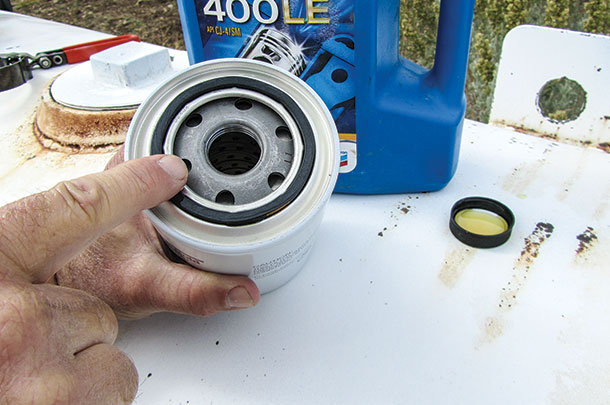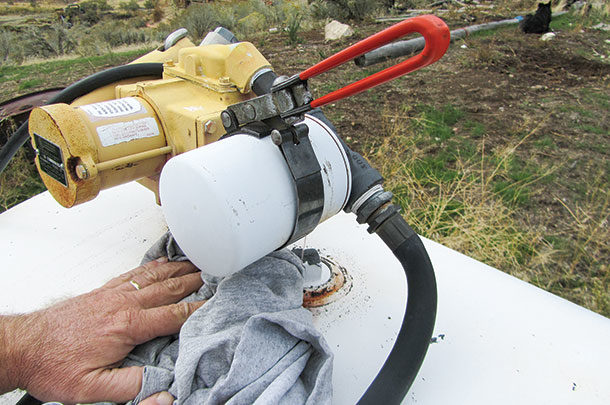If you are like the rest of us, there is at least a year’s worth of condensation collected in your bulk fuel storage tanks.It’s time to inspect the systems for leaks and damage, remove the moisture out of the fuel, change the fuel filters and treat the fuel before cold weather sets in – causing problems at a time when you are least equipped to deal with them.

This is a good time to perform a complete visual inspection of all the components of the bulk fuel storage tank system. Over time, bulk tanks can develop leaks at welds and seams.
Look for signs of leaking: Dirt and grime collected at points on the tank, or pools or puddles of fuel on the ground beneath the tank.
If you discover a leak, you will need to drain the tank and clean the area to have repaired thoroughly. You can repair leaks using JB Weld AutoWeld Gas Tank Repair or weld a steel tank with conventional welding.
If you have not welded a fuel tank before, seek the help and advice of a professional welder who has welded these tanks. Purge the tank completely of fuel and vapor, and vent the tank properly to prevent combustion leading to serious injury.
Next, inspect the valves for leaks. If you find a leak in the main shutoff valve of a gravity-flow bulk fuel tank, you will need to drain the tank before making repairs. Check fittings and the housing of fuel/water separator filters for leaks. If the housing of the filter system is cracked, you will need to replace the unit.
Carefully examine the condition of the delivery hose. Because they are made of rubber, they suffer damage from sunlight and oxygen (weather checking). It is common for these hoses to bulge or crack and leak. This can lead to a minor inconvenience, leaving the user covered in fuel, or a rupture – and cause you to lose gallons of fuel on the ground and create an environmental hazard.
If you find damage, replace the hose.
Inspect the delivery nozzle. A leak here could be a poorly sealed fitting or the seals of the delivery valve failing. If the nozzle valves are failing, replace the nozzle. Also check to make sure the valve works smoothly when you operate the handle.
If the valve sticks, replace the nozzle. If the valve is becoming sticky, it won’t be long before the valve sticks in the open position, preventing you from shutting off fuel flow. When this happens, the only way to shut off fuel flow is to shut off the pump or close the main valve – usually leaving you with a big mess.
After inspecting the physical components of the bulk fuel storage system, remove water from the fuel. Some gravity bulk fuel tanks – and most pump-style tanks – have a drain plug on the opposite end from the outlet. These tanks should be set up with quarter-inch fall or pitch per 1 foot of length toward the end of the tank containing the drain plug.
Be prepared to catch the fuel and water in a clean can or bucket. Carefully remove the drain plug slowly. This process is best performed with the tank less than a quarter full. Allow the fuel to flow into the catch bucket until the fuel is clear – not cloudy or milky – and transparent bubbles of water no longer stream with the fuel.
Bulk fuel tanks that do not have a drain plug (commonly gravity-flow systems) should be set up with the quarter-inch fall or pitch per 1 foot of tank length in the opposite direction, toward the fuel outlet.
These systems need to be set up with a water separator/fuel filtration system. These filters have a petcock on the bottom of the filter, and it is important they are installed to hang vertically with the petcock on the bottom.
To drain the water from these systems, open the main valve on the bulk tank and open the petcock. As in the previous example, capture the escaping fuel/water mix until the fuel runs out clear.
Once you have removed the water from the bulk tank, replace the fuel/water separator filter. Close the main tank valve and prepare to capture the fuel you will lose when you remove the filter. Remove the filter. Prep the gasket of the new filter with a thin coat of clean motor oil and install the filter.
Open the main valve or operate the pump to check for leaks by running some fuel into a vehicle or piece of equipment. If no fuel flows from the delivery nozzle of a gravity-flow system, the delivery hose and filtration system is air-locked.
Using a bucket to capture fuel, lower the hose to ground level and allow enough fuel to flow to displace the air in the system with fuel.
Finally, treat the diesel fuel in your bulk storage tanks. Measure the amount of fuel in the tank using a fuel stick and add the appropriate amount of anti-gel, moisture-dispersion agent. Your bulk fuel storage systems are now ready for winter. Continue to treat the diesel throughout the winter with each bulk fill-up. ![]()
PHOTO 1: This shows removal of the old spin-on fuel filter at the electric fuel pump on a 1,000-gallon, off-road diesel storage tank.
PHOTO 2: A thin coat of clean motor oil is applied to the fuel filter gasket. Photos by Michael J. Thomas.
Michael J. Thomas is a freelancer, stock producer and farm mechanic in Salmon, Idaho. Email Michael J. Thomas.











